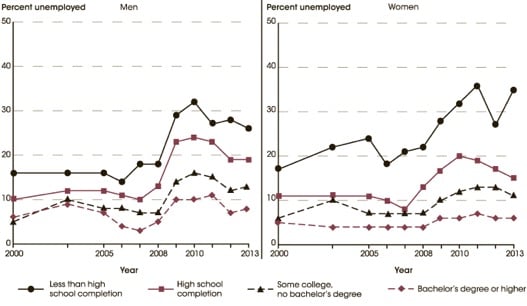Published on
Educational Attainment Matters

For institutions that offer adult-oriented two- and four-year professional programs, as well as graduate programs, there are many potential students who seek personal and professional advancement through postsecondary education. This prospective population is not new. Many people complete high school or its equivalent and attend a college without completing a degree. Consequently, re-marketing academic opportunities to those who started but have yet to finish a degree is very important for colleges and universities.
In recruiting students to return to school, there is a fundamental question to answer. What degree ought an adult seek? Answering this question is part of an array of variables impacting the academic success of adult learners.
As adults review websites for programs, they could conclude the information presented suggests adults are largely alike. There are, of course, some characteristics that ring true for the majority of adult students, but there are some stark differences as well. It’s important to understand both.
Similarities
Adults want to finish the degree, and given prior educational experiences, adults look for programs where timelines to complete are clear and accomplishable. This expectation is about persistence. Adult programs recognize determination is essential and often offer classes that only last five to twelve weeks rather than the traditional 15-week semester. Herein, progress to the degree is marked in deliberate steps.
Adults want flexibility. This attribute recognizes adult students come with classes to transfer, life experiences for prior learning assessments, the capacity to take CLEP exams (undergraduate only) and other experiences that can be used for academic credit. In addition, flexibility suggests to the student that, during the week-to-week learning expectations, there are opportunities to attend to many ongoing responsibilities associated with family, work, and other commitments while working toward a degree. The message to the adult learner is that adding one more responsibility to a busy life is achievable.
Clearly, returning adult students focus on careers, and the degrees available to adults have clout in the economy. Why? Adult learners have experienced the realities of the work place. They have first-hand knowledge of career opportunities given their educational accomplishments. They in turn seek a degree to enhance their career opportunities. Given this focus, few local, regional, and national colleges and universities offer traditional arts and sciences degrees in programs that are aligned to the adult market. The academic programs available for adults are clearly focused on careers.
Differences
There are differences as well. Among adult learners the question regarding educational attainment is very confusing with colleges and universities offering certifications, associate’s degrees, bachelor’s degrees and graduate degrees.
So a decision to be made by the adult in regards to returning to complete a degree should be made in light of U.S. Department of Education data.[1] For every seven undergraduate degrees conferred by two- and four-year institutions, four are awarded to females; for every five master’s degrees awarded, males earn two; and, among doctoral degrees earned there is a slight edge to females earning the degree over males. Gender may influence educational decisions.
The line graph below illustrates differences in educational attainment by gender relative to unemployment highlighting the relationship of educational attainment to employment by gender.

Note that the bachelor’s degree or higher line for women is rather consistent from year to year. This is unique relative to men with any level of education and to other women who have less education than a bachelor’s degree. The employment data for women with a bachelor’s degree or higher suggest stability for this population through recessionary cycles. Additional study of the chart indicates men with a bachelor’s degree or higher and almost all the other education attainment levels track similarly with the exception of women with less than a high school diploma. These data points on employment differences should motivate those who are beyond 24 years of age and do not have a bachelor’s degree to obtain one. If a person has a bachelor’s degree, the employment data for master’s and doctoral degree could be surmised to be even stronger.
An additional data point from the U.S. Bureau of Labor Statistics indicates significant differences between educational attainment and participation rates in the civilian workforce.[2] A person with some college or an associate’s degree has a seasonally adjusted participation rate of 66.82 percent across the most recent five months. Whereas, those with a bachelor’s degree or higher during the same time period have a 74.54 percent participation rate. Unemployment for the two groups during this time period is 5 percent as compared to 2.92 percent, respectively. Data are not available by gender.
These differences in the economy based on educational attainment are not part of the mainstream conversation with adult learners. Yet, the data represent the outcomes associated with the adult’s decision on which level of additional education should be obtained.
The use of data is an important point to consider because adult students need to drill into data as they review postsecondary programs. The performance differences in the economy based on educational attainment are evident. The line graph above indicates more volatility for those with less than a bachelor’s degree, and there are seemingly gender-based dynamics in play as well. Similarly, there is sufficient evidence in the Bureau of Labor Statistics data to encourage obtaining a bachelor’s degree or higher. Thus, the astute adult learner must drill into the data to determine which career program of study to pursue at the bachelor’s and/or graduate level in order to obtain better employment results and subsequently, ongoing economic stability.
– – – –
Footnotes
[1] Data from Table 301.10. Enrollment, staff, and degrees/certificates conferred in degree-granting and non-degree-granting postsecondary institutions, by control and level of institution, sex of student, type of staff, and level of degree: Fall 2010, fall 2011, and 2011-12
http://nces.ed.gov/programs/digest/d13/tables/dt13_301.10.asp
[2] The report is available at the following link: http://www.bls.gov/news.release/empsit.t04.htm.
Author Perspective: Administrator



